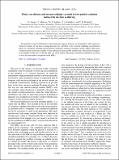| dc.contributor.author | Amaro, Jose Enrique | |
| dc.contributor.author | Maieron, C. | |
| dc.contributor.author | Caballero, J. A. | |
| dc.contributor.author | Donnelly, T William | |
| dc.date.accessioned | 2011-01-19T20:23:21Z | |
| dc.date.available | 2011-01-19T20:23:21Z | |
| dc.date.issued | 2010-10 | |
| dc.date.submitted | 2010-07 | |
| dc.identifier.issn | 0556-2813 | |
| dc.identifier.uri | http://hdl.handle.net/1721.1/60672 | |
| dc.description.abstract | Two-particle two-hole contributions to electromagnetic response functions are computed in a fully relativistic Fermi gas model. All one-pion exchange diagrams that contribute to the scattering amplitude in perturbation theory are considered, including terms for pionic correlations and meson-exchange currents (MECs). The pionic correlation terms diverge in an infinite system and thus are regularized by modification of the nucleon propagator in the medium to take into account the finite size of the nucleus. The pionic correlation contributions are found to be of the same order of magnitude as the MECs. | en_US |
| dc.description.sponsorship | United States. Dept. of Energy (grant DE-FC02-94ER40818) | en_US |
| dc.description.sponsorship | INFN-MEC Collaboration (Project no.FPA2008-03770-E-INFN) (Project no.ACI2009-1053) | en_US |
| dc.description.sponsorship | DGI (Spain) (Grant no. FIS2008-01143) (Grant no.FPA2006-13807-C02-01) (Grant no.FIS2008- 04189) (Grant no.FPA2007-62216) | en_US |
| dc.description.sponsorship | Consolider-Ingenio CPAN (Project) (Project No. CSD2007-00042) | en_US |
| dc.language.iso | en_US | |
| dc.publisher | American Physical Society | en_US |
| dc.relation.isversionof | http://dx.doi.org/10.1103/PhysRevC.82.044601 | en_US |
| dc.rights | Article is made available in accordance with the publisher's policy and may be subject to US copyright law. Please refer to the publisher's site for terms of use. | en_US |
| dc.source | APS | en_US |
| dc.title | Pionic correlations and meson-exchange currents in two-particle emission induced by electron scattering | en_US |
| dc.type | Article | en_US |
| dc.identifier.citation | Amaro, J. et al. “Pionic correlations and meson-exchange currents in two-particle emission induced by electron scattering.” Physical Review C 82.4 (2010): n. pag. © 2010 The American Physical Society | en_US |
| dc.contributor.department | Massachusetts Institute of Technology. Center for Theoretical Physics | en_US |
| dc.contributor.department | Massachusetts Institute of Technology. Department of Physics | en_US |
| dc.contributor.department | Massachusetts Institute of Technology. Laboratory for Nuclear Science | en_US |
| dc.contributor.approver | Donnelly, T. William | |
| dc.contributor.mitauthor | Donnelly, T. William | |
| dc.contributor.mitauthor | Amaro, Jose Enrique | |
| dc.relation.journal | Physical Review C | en_US |
| dc.eprint.version | Final published version | en_US |
| dc.type.uri | http://purl.org/eprint/type/JournalArticle | en_US |
| eprint.status | http://purl.org/eprint/status/PeerReviewed | en_US |
| dspace.orderedauthors | Amaro, J.; Maieron, C.; Barbaro, M.; Caballero, J.; Donnelly, T. | en |
| dc.identifier.orcid | https://orcid.org/0000-0002-3524-1432 | |
| mit.license | PUBLISHER_POLICY | en_US |
| mit.metadata.status | Complete | |
